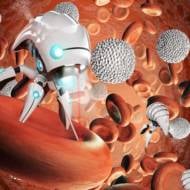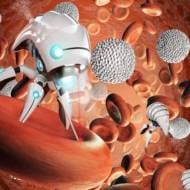
Israeli Nanotech Supercharges Human Body with ‘Healthy Electric Current’

The technology uses a new and very strong biological material, similar to collagen, which is non-toxic and causes no harm to the body’s tissues.
By TPS
A new nanotechnology development by an international research team led by Tel Aviv University researchers will make it possible to generate electric currents and voltage within the human body through the activation of various organs.
The researchers explain that the development involves a new and very strong biological material, similar to collagen, which is non-toxic and causes no harm to the body’s tissues.
The researchers believe that this new nanotechnology has many potential applications in medicine, including harvesting clean energy to operate devices implanted in the body, such as pacemakers, through the body’s natural movements, eliminating the need for batteries.
The study was led by Prof. Ehud Gazit of the Shmunis School of Biomedicine and Cancer Research at the Wise Faculty of Life Sciences, along with his lab team, Dr. Santu Bera and Dr. Wei Ji.
Researchers from the Weizmann Institute and a number of research institutes in Ireland, China and Australia also participated.
The researchers received two European Research Council Proof of Concept (ERC-POC) grants aimed at using the scientific research from the ERC grant that Gazit had previously won for applied technology.
Gazit explained that “Collagen is the most prevalent protein in the human body, constituting about 30% of all of the proteins in our body. It is a biological material with a helical structure and a variety of important physical properties, such as mechanical strength and flexibility, which are useful in many applications. However, because the collagen molecule itself is large and complex, researchers have long been looking for a minimalistic, short and simple molecule that is based on collagen and exhibits similar properties.”
“About a year and a half ago, in the journal Nature Materials, our group published a study in which we used nanotechnological means to engineer a new biological material that meets these requirements. It is a tripeptide – a very short molecule called Hyp-Phe-Phe consisting of only three amino acids – capable of a simple process of self-assembly of forming a collagen-like helical structure that is flexible and boasts a strength similar to that of the metal titanium,” he said.
“In the present study, we sought to examine whether the new material we developed bears another feature that characterizes collagen – piezoelectricity. Piezoelectricity is the ability of a material to generate electric currents and voltage as a result of the application of mechanical force, or vice versa, to create a mechanical force as the result of exposure to an electric field,” he added.
In the study, the researchers created nanometric structures of the engineered material, and with the help of advanced nanotechnology tools, applied mechanical pressure on them. The experiment revealed that the material does indeed produce electric currents and voltage as a result of the pressure.
Moreover, tiny structures of only hundreds of nanometers demonstrated one of the highest levels of piezoelectric ability ever discovered, comparable or superior to that of the piezoelectric materials commonly found in today’s market, most of which contain lead and are therefore not suitable for medical applications.
According to the researchers, the discovery of piezoelectricity of this magnitude in a nanometric material is of great significance, as it demonstrates the ability of the engineered material to serve as a kind of tiny motor for very small devices.
Next, the researchers plan to apply crystallography and computational quantum mechanical methods to gain an in-depth understanding of the material’s piezoelectric behavior and thereby enable the accurate engineering of crystals for the building of biomedical devices.
“Most of the piezoelectric materials that we know of today are toxic lead-based materials, or polymers, meaning they are not environmentally and human body-friendly. Our new material, however, is completely biological, and therefore suitable for uses within the body,” said Gazit.
For example, a device made from this material may replace a battery that supplies energy to implants like pacemakers, though it should be replaced from time to time. Body movements – like heartbeats, jaw movements, bowel movements, or any other movement that occurs in the body on a regular basis – will charge the device with electricity, which will continuously activate the implant.
Now, as part of their continuing research, the researchers are seeking to understand the molecular mechanisms of the engineered material with the goal of realizing its immense potential and turning this scientific discovery into applied technology.
At this stage, the focus is on the development of medical devices, but Prof. Gazit emphasizes that “environmentally friendly piezoelectric materials, such as the one we have developed, have tremendous potential in a wide range of areas because they produce green energy using mechanical force that is being used anyway.”
For example, a car driving down the street can turn on the streetlights. These materials may also replace lead-containing piezoelectric materials that are currently in widespread use, but that raise concerns about the leakage of toxic metal into the environment.
PLANT FRUIT TREES BEFORE ISRAEL’S SABBATICAL YEAR BEGINS!
HELP ISRAELI FARMERS PLANT NOW – BEFORE SHMITA!
TIME RUNNING OUT to make the Land even more fruitful while helping Israeli farmers offset financial losses from Covid, Hamas arson fires and the upcoming Sabbatical year.
“…the seventh year shall be a complete rest for the Land…”
“…I will ordain My blessing for you…”
(Leviticus 25:4,21)
CLICK TO PLANT YOUR FRUIT TREES IN ISRAEL TODAY, BEFORE IT’S TOO LATE!
The post Israeli Nanotech Supercharges Human Body with ‘Healthy Electric Current’ first appeared on United with Israel.
United with Israel
